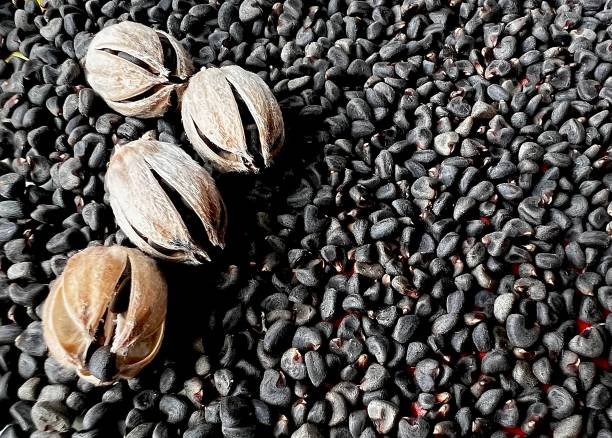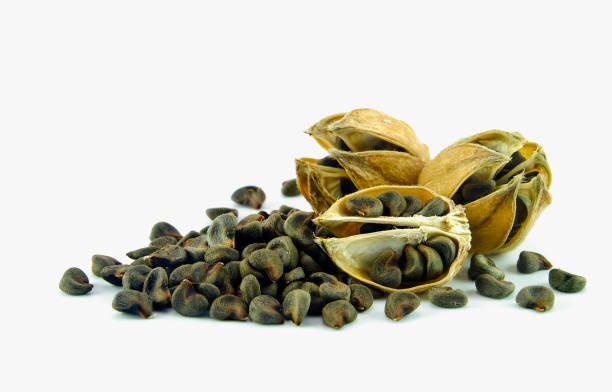Hibiscus Seeds :
Description:
Hibiscus seeds come from the Hibiscus sabdariffa plant, known for its vibrant red flowers. The seeds are small, round, and typically dark brown or black in color. They are hard and have a smooth texture. Hibiscus seeds are primarily used for planting purposes, as the plant is cultivated for its flowers, which are used in teas, juices, and as a natural food coloring. The seeds themselves are not commonly consumed directly but are used to propagate new plants.
Hibiscus plants are valued for their antioxidant-rich flowers, and the seeds are important for growing future crops of hibiscus for culinary and medicinal uses.
Physical Characteristics :
1. Size and Shape: Hibiscus seeds are small, typically ranging from 2-4 mm in length, and are oval-shaped.
2. Color: The seeds are usually dark brown or black in color, though some variations may appear slightly lighter.
3. Texture: Hibiscus seeds have a smooth and hard outer surface, giving them a firm texture. They are not soft or easily crushed.
4. Weight: Hibiscus seeds are relatively lightweight compared to their size, making them easy to handle and store.
5. Aroma and Flavor: The seeds themselves have a neutral or slightly earthy aroma, with little flavor. They are not typically consumed for taste but for their role in reproduction and cultivation of the hibiscus plant.
Chemical Characteristics :
1. Fatty Acids: Hibiscus seeds contain a moderate amount of lipids, including essential fatty acids such as linoleic acid (omega-6) and oleic acid (omega-9). These fatty acids are beneficial for maintaining healthy skin and promoting overall health.
2. Proteins: The seeds are a source of plant-based proteins, contributing to muscle repair and growth. The protein content is typically around 25-30% of the seed’s composition.
3. Carbohydrates: Hibiscus seeds contain carbohydrates, primarily in the form of fiber. This fiber contributes to digestive health by promoting regular bowel movements.
4. Minerals: Hibiscus seeds are rich in essential minerals such as calcium, iron, magnesium, and potassium, which support bone health, oxygen transport, muscle function, and heart health.
5. Antioxidants: Hibiscus seeds, like the flowers, contain antioxidants that help neutralize free radicals and reduce oxidative stress, which can benefit overall health and potentially reduce the risk of chronic diseases.
6. Phytochemicals: Hibiscus seeds contain bioactive compounds such as flavonoids and phenolic compounds, which have antioxidant, anti-inflammatory, and antimicrobial properties. These compounds may offer additional health benefits when consumed in moderation.
Nutritional Information (per 100 grams)
Calories: 226 kcal
Protein: 10.1 g
Total Fat: 13.2 g
Saturated Fat: 1.5 g
Monounsaturated Fat: 3.2 g
Polyunsaturated Fat: 7.4 g
Carbohydrates: 48.6 g
Dietary Fiber: 4.5 g
Sugars: 1.8 g
Vitamins: Vitamin A: 42 Iu -Vitamin C: 12.5 mg-Vitamin E: 0.5 mg-Vitamin B1 (Thiamine): 0.16 mg-Vitamin B2 (Riboflavin): 0.10 mgVitamin B3 (Niacin): 0.7 mg
Minerals: Calcium: 130 mg-Iron: 4.5 mg-Magnesium: 90 mg-Phosphorus: 100 mg
-Potassium: 220 mg-Sodium: 4 mg-Zinc: 1.2 mg
Quality Standards
“Compliant with local and European standards according to food safety regulations.”
1. Purity: Hibiscus seeds should have a purity level of at least 98-99%, free from foreign matter such as dirt, stones, and other seeds.
2. Moisture Content: The moisture content should not exceed 8-10% to prevent mold growth, spoilage, and to maintain the longevity of the seeds during storage.
3. Size and Shape: The seeds should be uniform in size and shape to ensure consistency in packaging and quality. They should not be broken or deformed.
4. Color and Appearance: Hibiscus seeds should be dark brown or black, with no signs of discoloration, mold, or damage. Uniform color indicates proper maturity and processing.
5. Odor and Flavor: The seeds should have a neutral or slightly earthy aroma. Any off-odors or signs of rancidity indicate poor storage or deterioration.
6. Foreign Matter: The seeds should be free from foreign matter like stones, dust, or any other contaminants, ensuring a high level of purity.
7. Pest-Free: The seeds must be free from pests, insects, or any damage caused by animals or insects during storage or transport.
8. Microbial Safety: Hibiscus seeds should meet microbiological safety standards, with no presence of harmful bacteria, fungi, or mold. Testing for common pathogens like Salmonella and E. coli is important to ensure they are safe for consumption or planting.
9. Aflatoxins and Mycotoxins: Hibiscus seeds should be free from aflatoxins and other mycotoxins, and should comply with international regulations on toxin levels to ensure safety and quality.
Microbiological Standards :
1. Total Plate Count (TPC): The total microbial load should not exceed 1 × 10⁴ CFU/g to ensure that the seeds are free from excessive bacterial or fungal contamination.
2. Yeast and Mold Count:The count of yeasts and molds should be less than 1 × 10³ CFU/g to prevent the growth of fungi that could affect the quality and safety of the seeds.
3. Coliform Bacteria:
Coliform bacteria should be absent in 1g of seeds. The presence of these bacteria indicates poor hygiene during processing or storage.
4. Escherichia coli (E. coli): E. coli should be absent in 1g of seeds, as its presence indicates contamination from human or animal waste, which is a serious food safety concern.
5. Salmonella spp.: Salmonella should be absent in 25g of seeds. The presence of Salmonella is a critical health risk, and its absence is a key requirement for safe seed distribution.
6. Aflatoxins (B1, B2, G1, G2): Hibiscus seeds should be tested for aflatoxins, and levels should be below the regulatory limits (usually <10 ppb for total aflatoxins) to ensure the seeds are safe for consumption or planting.
7. Pathogenic Bacteria: Hibiscus seeds must be free from pathogenic bacteria like Listeria monocytogenes and Campylobacter, which could cause serious health issues.
10. Packaging and Labeling: The packaging should be airtight, moisture-resistant, and made of food-grade material to preserve the quality of the seeds. Proper labeling with product information, batch number, and expiration date is essential.
Packaging and Storage :
1. Packaging:
As per the customer’s request, polypropylene bags and cartons.”
2. Storage:
Temperature: Hibiscus seeds should be stored in a cool, dry environment with a temperature range between 15°C and 20°C (59°F to 68°F) to prevent degradation.
Humidity: Relative humidity in storage areas should be maintained below 60% to avoid the risk of mold and mildew growth that could spoil the seeds.
Ventilation: Adequate ventilation should be maintained to ensure proper airflow and prevent moisture accumulation that could damage the seeds.
Pest Control: The storage area must be kept clean and free from pests such as insects or rodents to prevent contamination of the seeds.
Storage Method: Seeds should be stored off the floor, preferably on pallets, to avoid moisture contact and to allow for better airflow. Packages should be stacked properly to prevent damage.
First In, First Out (FIFO): To ensure the oldest stock is used first and the quality of the seeds is maintained, the FIFO method should be followed for inventory rotation.
Shelf Life :
Hibiscus seeds generally have a shelf life of 1 to 2 years when stored under optimal conditions. To ensure the seeds remain fresh and maintain their quality, the following storage guidelines should be followed:
Temperature: Store the seeds in a cool, dry place, ideally between 15°C and 20°C (59°F and 68°F).
Humidity: Keep the relative humidity below 60% to prevent moisture from causing mold or deterioration.
Packaging: Ensure the seeds are in airtight, moisture-resistant packaging to protect against external elements like air, light, and moisture.
If stored properly, hibiscus seeds will retain their quality, germination potential, and nutritional value for up to two years. However, it’s always recommended to check the expiration date or batch number for more accurate shelf life information.
Traceability and Compliance;
Origin :Egypt
Application:
Propagation: The primary use of hibiscus seeds is for propagating new hibiscus plants. They are planted to grow Hibiscus sabdariffa for its flowers, which are used in various products like teas, juices, and as a natural dye.
Although hibiscus seeds are not commonly consumed directly, the hibiscus flowers are widely used in teas, herbal beverages, jams, and syrups. The seeds are mainly used for growing the plant to produce these flowers.
Hibiscus tea made from the flowers is known for its potential health benefits, such as lowering blood pressure, improving cholesterol levels, and offering antioxidant properties. The seeds themselves do not have the same medicinal uses, but they play a role in the overall cultivation of the plant for these health benefits.
Hibiscus extracts from the flowers (not the seeds) are used in hair care and skin care products for their anti-aging, moisturizing, and anti-inflammatory properties. The seeds, however, are not typically used directly in cosmetics.
In some regions, hibiscus seeds are used in animal feed for their nutritional value. The seeds provide essential nutrients such as protein, fat, and fiber, which benefit livestock and poultry.
Contact information:


